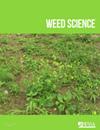阿肯色州东部麦草畏空气浓度及其对大豆的影响
IF 2.1
2区 农林科学
Q2 AGRONOMY
引用次数: 0
摘要
摘要近年来,在种植并喷洒除草剂的麦草畏抗性大豆和棉花的地区,对非麦草畏抗药性大豆[Glycine max(L.)Merr.]的损害一直很常见。在阿肯色州西北部进行了脱靶运动田间试验,以确定空气中麦草畏浓度与非DR大豆症状程度之间的关系。此外,还评估了阿肯色州东部两个地点空气样本中麦草畏的频率和浓度,以及影响空气样本中除草剂检测的环境条件。处理应用包括560 g ae ha–1(1X速率)的麦草畏、860 g ae ha-1的草甘膦,以及1%v/v的颗粒漂移阻燃剂,应用于不同植被程度的0.37-ha田地。空气样本中麦草畏浓度与非DR大豆对除草剂的反应之间的关系在可见损伤(广义R2=0.82)比高度降低(广义R2=0.043)更具预测性。单次暴露导致大豆10%损伤的麦草畏空气浓度预测为1.60 ng m–3 d–1。单次接触麦草畏导致身高下降10%的预测浓度为3.78 ng m–3 d–1。麦草畏在阿肯色州东部经常被检测到,在采样期间,每天检测到的麦草畏超过1.60 ng m–3的情况发生了17次。记录的麦草畏最大浓度为7.96 ng m–3 d–1,而在2020年采集的6个样本和2021年采集的22个样本中,Marianna和Keiser的麦草虫浓度≥1 ng m–3d–1。在收集的空气样本中始终检测到麦草畏,这表明该地区的麦草畏使用量很高,而且在很长一段时间内可能对大豆造成损害。需要更多的研究来量化挥发性麦草畏的植物吸收率,并评估气态麦草畏多次暴露对非目标植物物种的影响。本文章由计算机程序翻译,如有差异,请以英文原文为准。
Dicamba Air Concentrations in Eastern Arkansas and Impact on Soybean
Abstract Damage to non–dicamba resistant (non-DR) soybean [Glycine max (L.) Merr.] has been frequent in geographies where dicamba-resistant (DR) soybean and cotton (Gossypium hirsutum L.) have been grown and sprayed with the herbicide in recent years. Off-target movement field trials were conducted in northwest Arkansas to determine the relationship between dicamba concentration in the air and the extent of symptomology on non-DR soybean. Additionally, the frequency and concentration of dicamba in air samples at two locations in eastern Arkansas and environmental conditions that impacted the detection of the herbicide in air samples were evaluated. Treatment applications included dicamba at 560 g ae ha–1 (1X rate), glyphosate at 860 g ae ha–1, and particle drift retardant at 1% v/v applied to 0.37-ha fields with varying degrees of vegetation. The relationship between dicamba concentration in air samples and non-DR soybean response to the herbicide was more predictive with visible injury (generalized R2 = 0.82) than height reduction (generalized R2 = 0.43). The predicted dicamba air concentration resulting in 10% injury to soybean was 1.60 ng m–3 d–1 for a single exposure. The predicted concentration from a single exposure to dicamba resulting in a 10% height reduction was 3.78 ng m–3 d–1. Dicamba was frequently detected in eastern Arkansas, and daily detections above 1.60 ng m–3 occurred 17 times in the period sampled. The maximum concentration of dicamba recorded was 7.96 ng m–3 d–1, while dicamba concentrations at Marianna and Keiser, AR, were ≥1 ng m–3 d–1 in six samples collected in 2020 and 22 samples in 2021. Dicamba was detected consistently in air samples collected, indicating high usage in the region and the potential for soybean damage over an extended period. More research is needed to quantify the plant absorption rate of volatile dicamba and to evaluate the impact of multiple exposures of gaseous dicamba on non-targeted plant species.
求助全文
通过发布文献求助,成功后即可免费获取论文全文。
去求助
来源期刊

Weed Science
农林科学-农艺学
CiteScore
4.60
自引率
12.00%
发文量
64
审稿时长
12-24 weeks
期刊介绍:
Weed Science publishes original research and scholarship in the form of peer-reviewed articles focused on fundamental research directly related to all aspects of weed science in agricultural systems. Topics for Weed Science include:
- the biology and ecology of weeds in agricultural, forestry, aquatic, turf, recreational, rights-of-way and other settings, genetics of weeds
- herbicide resistance, chemistry, biochemistry, physiology and molecular action of herbicides and plant growth regulators used to manage undesirable vegetation
- ecology of cropping and other agricultural systems as they relate to weed management
- biological and ecological aspects of weed control tools including biological agents, and herbicide resistant crops
- effect of weed management on soil, air and water.
 求助内容:
求助内容: 应助结果提醒方式:
应助结果提醒方式:


